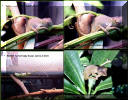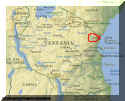Chamowners Web - Family Tree Pages
Bradypodion fischeri fischeri (subspecies)
KINGDOM: Animalia (animals)
PHYLUM: Cordata (chordates)
CLASS: Reptilia (reptiles)
ORDER: Squamata (scaled reptiles)
FAMILIES: snakes, warm lizards, lizards
LIZARD SUBFAMILY: Sauria
SAURIA INFRAORDER:
Anguimorpha (angid); Gekkota (gecko); Iguania (iguana); Scincomorpha (skink)
IGUANIA DIVISIONS:
Agamids; Iguanids; Chameleonids
CHAMAELEONIDAE FAMILY:
Subfamily Chamaeleoninae (True Chameleons)
Genus Bradypodion ("slow-footed")
Bradypodion fischeri fischeri
UNDERLINED TEXT IS LINKED TO A DEFINITION
IF THE TERM IN THE DEFINITION IS UNDERLINED IT IS LINKED TO AN ILLUSTRATION
| Distribution:
Nguru Mtns., and Eastern Usambara Mtns., Tanzania |
|
| Common Name | Fischer's, Usambara Two-Horned |
| Name Translation | of fischer |
| Synonyms | Chamaeleo fischeri fischeri |
| Discovered | Reichenow, 1887 |
| Size | medium 30 - 40 cm or 12-16 inches |
| Sexual Dimorphism | Males are larger, and have a swollen tail base (hemipenal bulge). Female's horns are smaller or not present at all, and the females dorsal crest does not usually extend past the first third of the body. |
| Parity | oviparous |
| Description | The head has a flat casque with no occipital lobes, canthus rostralis projects on both sides to a flat horn covered by enlarged heterogeneous scales. These horns are normally parallel. there is no gular crest. Body scalation is mostly homogeneous with enlarged scales on the throat and limbs. The dorsal crest extends through the tail and is covered with high conical scales, which are tallest toward the head. Colors displayed consist of green, turquoise, black, gray, brown, white, yellow, and orange. |
| Photo |
 |
literature cited (1,2,5,6,7,8,9,17, 18)

